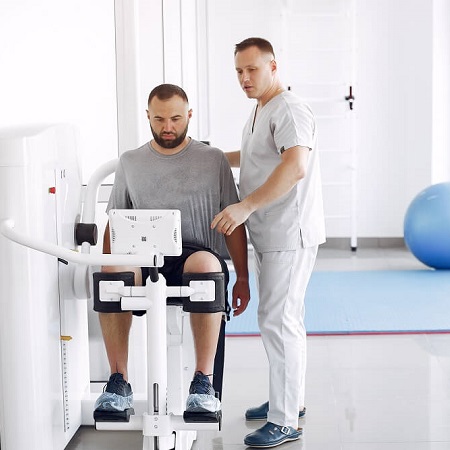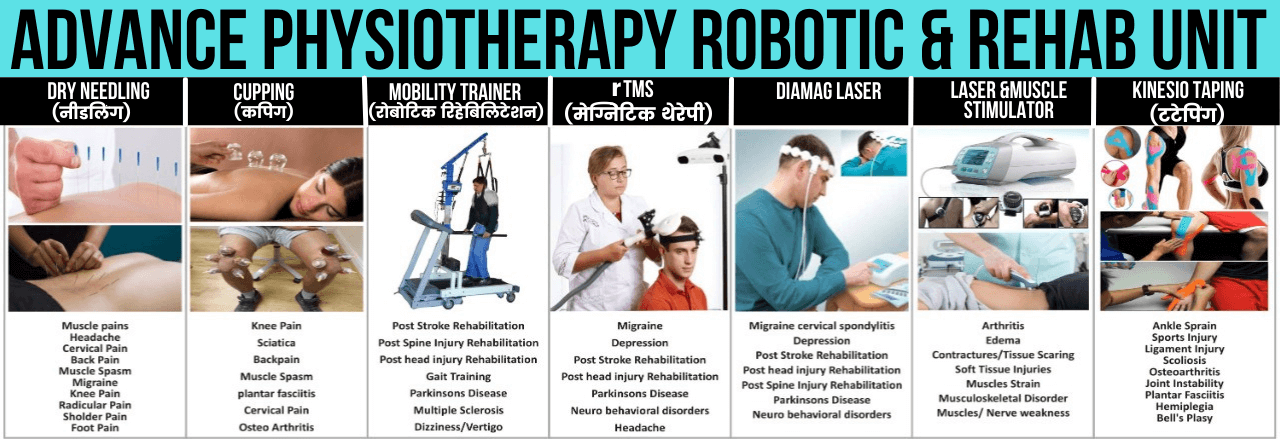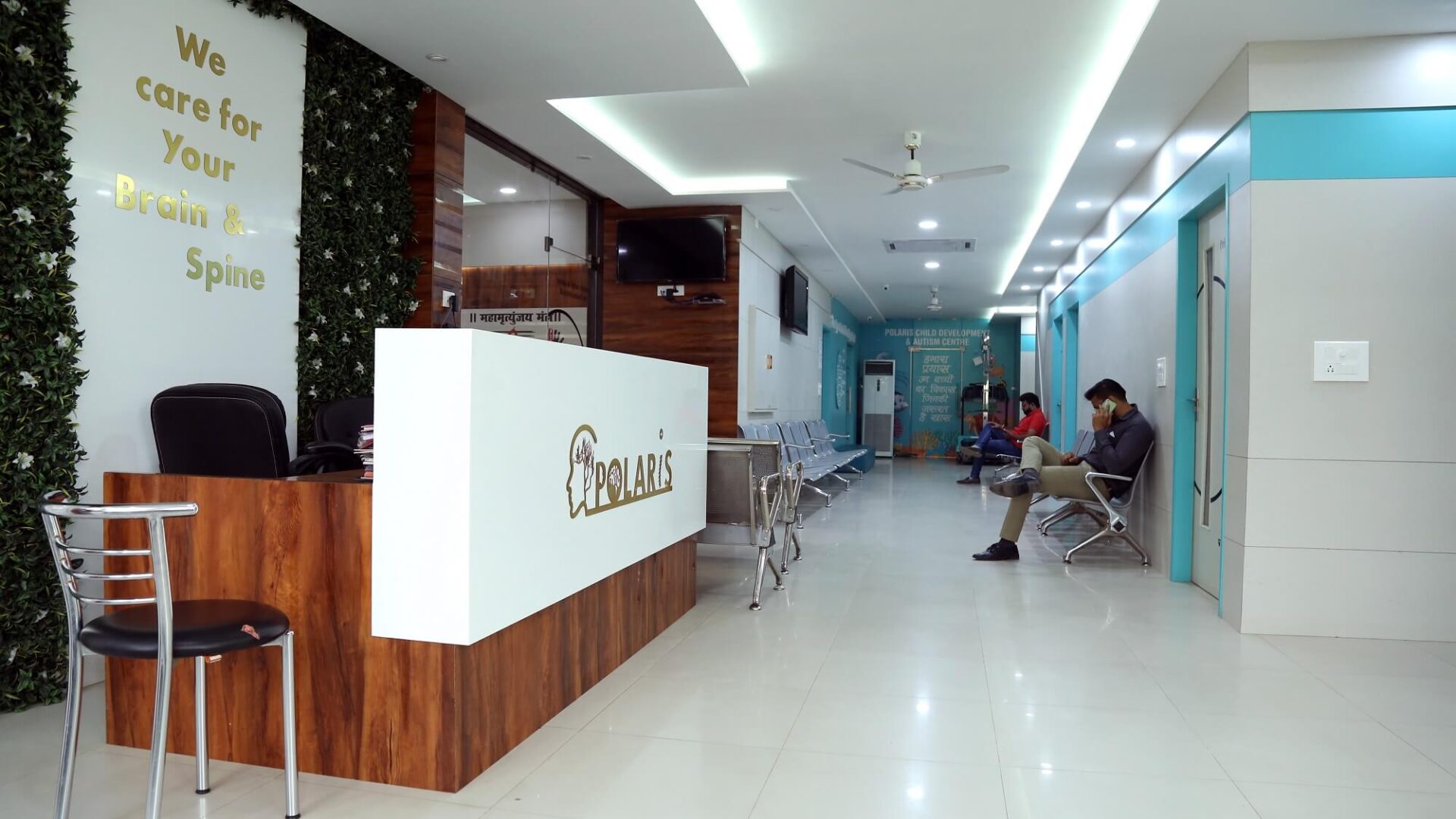We' Ve Built A Long Standing Relationship Based On Trust
Welcome to Advance Physiotherapy Robotic & Rehab Unit



Dry needling is an invasive procedure where a fine needle is inserted into the skin and muscle ,it is aimed at myofascial trigger point.
– Identofication of myofascial trigger points in the muscle through palpation .
– Deep dry needling reproduces the patient pattern of pain
– identication of jump and shoot sign on palpation on myofascial trigger points (MrTP)
Cupping therapy is a form of therapy where suction cups are placed around various parts of the body . Cupping is used for a very wide range of conditions although most of these will be related to either the blood of muscles .It is often used for pain and in particular muscle pain although it’s also used for things like acne , shingles ,knee pain , cervical and back pain.
This is helpful in teaching the patient walking training and coordination while walking .Helps in post-stroke rehabilitation ,Post-Spine injury rehabilitation, Gait Training, Parkinson and the like.
Repetitive Transcranial Magnetic Stimulation is a form of brain of brain stimulation therapy used to treat depression and anxiety
The therapy involves using a magnet to target and stimulate certain areas of the brain .rTms treat depression ,bipolar disorders, Migraine and post stroke condition.
Dry needling is an invasive procedure where a fine needle is inserted into the skin and muscle ,it is aimed at myofascial trigger point.
– Identofication of myofascial trigger points in the muscle through palpation .
– Deep dry needling reproduces the patient pattern of pain
– identication of jump and shoot sign on palpation on myofascial trigger points (MrTP)
Laser is the acronyn for Light Amplification by Stimulated Emission of Radiation .
A laser light is monochromatic,collimated and coherent .
A laser is a device that produces such a light effects of Laser .
Reduction of inflammation it can occur within Hours to days . Laser is used for Accelerated tissue regeneration , Osteoarthritis of the knee,hip and ankle , Rheumatoid arthritis ,Low back disc degeneration , Sciatica, Tendonitis ,Plantar Fascitis, Tennis elbow , Neuropathic pain.
Kinesiology taping is a therapeutic tool and has become increasingly popular within the sporting arena . Taping has been used for a long time for the prevention and treatment of injuries .
Tape is commonly used by Physiotherapist to.
– Relieve your pain , improve joint stability .
– Enhance athlete confidence , reduce injury , recurrence, prevent injury .
– Stabilise or support an injury.
– Facilitate normal movement , muscles action or postural pattern.
We' Ve Built A Long Standing Relationship Based On Trust
REHAB PROGRAMS
Your rehabilitation begins in the hospital, not long after your injury.
As you progress though our rehabilitation program you will work with
many different health care providers.
We want you to be as strong and
healthy as you can, so you can get back to community life.
Who are the health care providers that
will help me with my goals?
You will be working with health care providers from:
• physiotherapy and occupational therapy
• nursing and pharmacy
• dietary and therapeutic recreation
• respiratory therapy
• social work, psychology, and chaplaincy
• speech language pathology
• SCI regional service coordinator and a peer support
.
Occupational Therapist (OT)
• assesses ways for you to do daily tasks
such as dressing, going to the bathroom,
eating, household chores and skills
needed for work
• assesses and recommends wheelchairs
and seating needs and bathroom safety
equipment
• completes a home access assessment
• makes recommendations for home
modifications and other equipment needs
• provides information on returning to drive.
Physiotherapist (PT)
• helps with moving, walking, balance,
fitness, strength and coordination
• teaches wheelchair skills
• teaches breathing exercises
• provides patient and family education
• teaches swimming
Pool Instructor and Physiotherapy
Assistant (PTA) works with the PT.
Spasticity-
Treatment for spasticity usually involves a combination of the following options:
Exercises. Physical and occupational therapists can teach you stretching, positioning and exercise activities that may help maintain range of motion and prevent shortening or tightening of the muscles (contracture).
Oral medications. Certain prescribed medications given by mouth (orally) may help reduce muscle spasticity
Injections. Botulinum toxin (Botox) injections into affected muscles may decrease the muscle signals that cause spasticity. The injections provide temporary relief, allowing you to move and strengthen your muscles. You may have injections every three months.
The goal of stroke rehabilitation is to help you relearn skills you lost when a stroke affected part of your brain. Stroke rehabilitation can help you regain independence and improve your quality of life.
The severity of stroke complications and each person’s ability to recover vary widely. Researchers have found that people who participate in a focused stroke rehabilitation program perform better than most people who don’t have stroke rehabilitation.
What’s involved in stroke rehabilitation?
There are many approaches to stroke rehabilitation. Your rehabilitation plan will depend on the part of the body or type of ability affected by your stroke.
Physical activities might include:
Motor-skill exercises. These exercises can help improve your muscle strength and coordination. You might have therapy to strengthen your swallowing.
Mobility training. You might learn to use mobility aids, such as a walker, canes, wheelchair or ankle brace. The ankle brace can stabilize and strengthen your ankle to help support your body’s weight while you relearn to walk.
Constraint-induced therapy. An unaffected limb is restrained while you practice moving the affected limb to help improve its function. This therapy is sometimes called forced-use therapy.
Range-of-motion therapy. Certain exercises and treatments can ease muscle tension (spasticity) and help you regain range of motion.
Technology-assisted physical activities might include:
Robotic technology. Robotic devices can assist impaired limbs with performing repetitive motions, helping the limbs to regain strength and function.
Virtual reality. The use of video games and other computer-based therapies involves interacting with a simulated, real-time environment.
Cognitive and emotional activities might include:
Therapy for cognitive disorders. Occupational therapy and speech therapy can help you with lost cognitive abilities, such as memory, processing, problem-solving, social skills, judgment and safety awareness.
Therapy for communication disorders. Speech therapy can help you regain lost abilities in speaking, listening, writing and comprehension.
Psychological evaluation and treatment. Your emotional adjustment might be tested. You might also have counseling or participate in a support group.
Medication. Your doctor might recommend an antidepressant or a medication that affects alertness, agitation or movement.
Sports injury rehabilitation is a safe, therapeutic approach that helps athletes effectively treat pain and achieve optimal performance with:
- Targeted exercises to help you
return to pre injury function. - Personalized exercise prescription to
improve mobility restrictions. - Reduced susceptibility to further
sport-related injuries. - Preparation to avoid recurring injury
episodes. - Achieving peak athletic performance.
- Sports injury rehabilitation treats a range of conditions, including:
-Acute sports injuries
-Strains
-Sprains
-Muscle, tendon and ligament repairs
-Tendonitis
-Hand injuries
-Shoulder dislocation
-Foot or ankle dysfunction
-Surgery rehab
*The sports injury rehabilitation program will benefit those with:
-Post-operative injuries
-ACL reconstruction
-Meniscus tears
-Rotator cuff repair
-Acute and chronic musculoskeletal
injuries.
-Sprains and strains
-Tedonitis and bursitis
How it Works:-
Sports Injury Rehabilitation is a multi-disciplinary approach to the prevention, evaluation, and treatment of injuries.
The first step towards recovery is getting an accurate diagnosis from a certified sports-injury specialist. Typically, the initial stage of treatment involves reducing pain and promoting healing.
Once pain and swelling are reduced, progressive reconditioning treatment will begin.
Exercises will be prescribed to target specific goals such as mobility, flexibility training, coordination of balance and joint positioning.
As progress is made, the athlete and trainer can work together towards re-establishing strength.
We use state-of-the-art techniques and procedures, including:
-Functional activities
-Sports/activity-specific exercises and
training
-Bracing and taping (athletic and
kinesiotaping)
-Fabrication of protective pads
-Modalities
-Manual Therapy
-Muscle reconditioning
-Proprioceptive training
Health Benefits:-
Sports Injury Rehabilitation is critical to help ensure you return to the activities you love as quickly and as safely as possible.
We are committed to providing state-of-the-art clinical care for athletes of all ages and skill levels. Although you may be injured, you can still stay in shape, and can use the injury period as an opportunity to strengthen other areas of the body.
A personal, committed investment in healing is a strategy that will help you regain optimal performance.
After an injury or surgery, an exercise conditioning program will help you return to daily activities and enjoy a more active, healthy lifestyle. Following a well-structured conditioning program will also help you return to sports and other recreational activities.
This is a general conditioning program that provides a wide range of exercises. To ensure that the program is safe and effective for you, it should be performed under your doctor’s supervision. Talk to your doctor or physical therapist about which exercises will best help you meet your rehabilitation goals.
Strength: Strengthening the muscles that support your shoulder will help keep your shoulder joint stable. Keeping these muscles strong can relieve shoulder pain and prevent further injury.
Flexibility: Stretching the muscles that you strengthen is important for restoring range of motion and preventing injury. Gently stretching after strengthening exercises can help reduce muscle soreness and keep your muscles long and flexible.
Taping may be used to help facilitate your rotator cuff and shoulder deltoid muscle. It can augment your physical therapy exercises to ensure that you quickly gain strength and proper motion around your shoulder.
We assess not only your problematic area but whole of your spine. By our specialized assessment we find out all the subluxations/ misalignments in your vertebral column (back-bone), muscular tightness/ weakness, ROM, ligament laxity, trigger points, etc.
Accordingly, we treat all the reactive elements in your spine. Once your pain subsides and all the corrections done, we incorporate Back Care programme which is a series of conditioning exercises for the core muscles to achieve stability in various body positions or postures.
We provide a highly Scientifically acclaimed advanced exercises that strengthens the core and tones up the abdominal, gluteus and thigh musculature which is crucial for preventing recurrence of your back pain and enhancing your performance.
